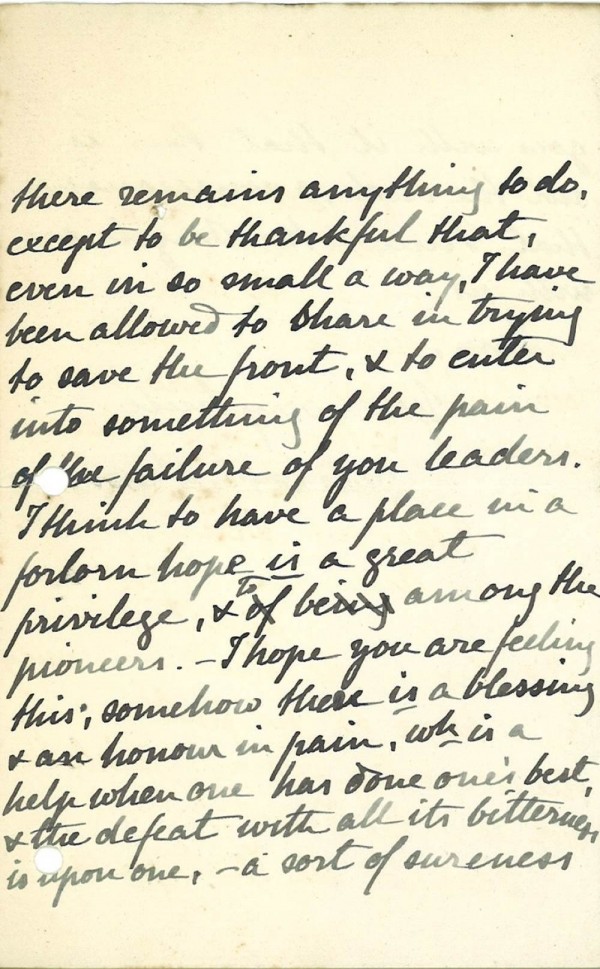Letters From The Society For The Protection Of Ancient Buildings’ Archive
These are just a few letters I found in the archive at the Society for the Protection of Ancient Buildings in Spital Sq, confirming that my own modest involvement in the successful campaign to save the Marquis of Lansdowne has many noble precedents, as over the last one hundred and thirty years, many writers and artists have sought to use their influence in a similar vein. Celebrating National Explore Your Archive Week, it is my pleasure to publish these letters for the first time – click on any one of the images below to enlarge and read the text.
William Morris wrote to the Reverend H. West of the church at North Fordingham to express the Society’s disapproval about proposed building works and the letter encapsulates the founding principles of the SPAB in Morris’s own hand. They strongly objected to the Victorian passion for ‘restoring’ medieval buildings to an imagined state of antiquity. Believing this work to be pastiche and worse, Morris understood that it injured historic fabric as the guilty parties stripped and destroyed to achieve their own, largely inaccurate vision of what the building should have looked like. The word ‘restore’ is particularly significant as it implies putting back things that weren’t necessarily there in the first place. ‘Repair’ is still the Society’s operative word.
Reports of destructive activities came to the Society from many famous correspondents – here George Gilbert Scott ( Architect of St Pancras Station) writes of damage to the church at Mells in Somerset.
Edward Burne Jones write to Thackeray Turner (one of the earliest SPAB Secretaries) regarding problems at Worcester Cathedral on February 9th, 1897
William Holman Hunt wrote with great passion to Morris about his concerns over proposed ‘extensive repairs’ to the Great Mosque in Jerusalem. He writes with dismay that the gates have been painted “a vivid pea green that would disgrace a Whitechapel Shop front.”
Thanks to the concern of Charles Robert Ashbee, designer & founder of the School of Handicraft in Bow, the magnificent seventeenth century Trinity Almshouses still stand in Whitechapel today..
Octavia Hill, social reformer and one of the founders of the National Trust, wrote this grief struck letter about proposed alterations to the West Front of Peterborough Cathedral.
In his professional guise as an architectural surveyor, Thomas Hardy was a committed SPAB caseworker protecting churches in the West Country. In these hastily scribbled cards he writes in anguish over Puddletown Church which featured in Tess of the D’Urbevilles.
George Bernard Shaw wrote to the Society on 15th July 1929, enquiring over the wisdom of restoration at the church in Ayot St Lawrence.
John Betjeman wrote to ask for SPAB’s advice on the Unitarian Chapel, Newbury, which was built in 1697. Three months previously, it was sold to the YWCA who were raising funds to ‘repair’ it.
As a SPAB council member, John Betjeman wrote this comic note signed pseudonymously – indicative of the humour that prevailed.
Letters courtesy of Society for Protection of Ancient Buildings
You may also like to read about







































How good that there are always a few people who care, and who are prepared to raise their voices – or put pen to paper – to let the world know what is happening. But it is sad that greed and get-rich-quick hopes and indifference make so many ears deaf and eyes blind to what is happening. Thanks for printing the letters! Valerie
Echoing Valerie – so good to see that there are people who care about community – the more, the better.
A timely reminder that passion to influence is NOT just a luxury for the living. Felt such a intense personal act hearing these voices from the dead.
Why on earth these wretched restorers & repairesr cant leave well alone I really dont know I thought the letter about the almshouses & their residents’ health put it very well.If it aint broke dont fix it!
43 Cloth Fair, London EC1.
Is that a street name?
Does it still exist?
Never heard of it.
Cloth Fair is an ancient narrow street in Smithfield next to St Bartholomew’s Church and today there is a blue plaque for John Betjeman at number 43.
What an inspiring set of letters! I will proudly continue with my fight to save old buildings, knowing I am following in illustrious footsteps.
Incidentally, 43 Cloth Fair is a Landmark Trust flat – you can stay there. I know. I have. It was while staying there we discovered Spitalfields and Clerkenwell, as well as going on some marvellous pub crawls – strictly in the interests of research. It even motivated me to write a poem – but I won’t bore you with it.
Really lovely to come across these. Thank you for posting them.
I think that you will find that the letter attributed to George Gilbert Scott, “architect of St. Pancras station”, alerting the SPAB to what Woodyer was up to at Mells, is from his son George Gilbert Scott Junior. Sir George had died the previous year, which is probably why the writer is in mourning (hence the black-edged paper). Given the public abuse that Morris hurled at Sir George’s work to ancient buildings it would indeed have been surprising if the letter had come from him. Scott Junior’s work was, in the spirit of the SPAB, far kinder to historic buildings.
With thanks & best wishes.